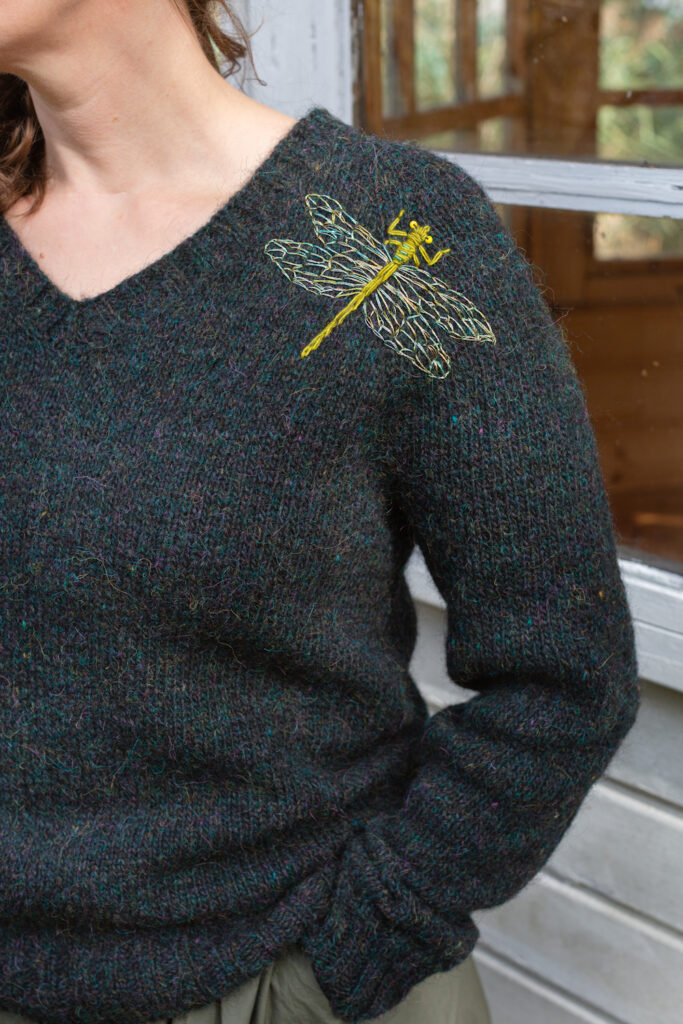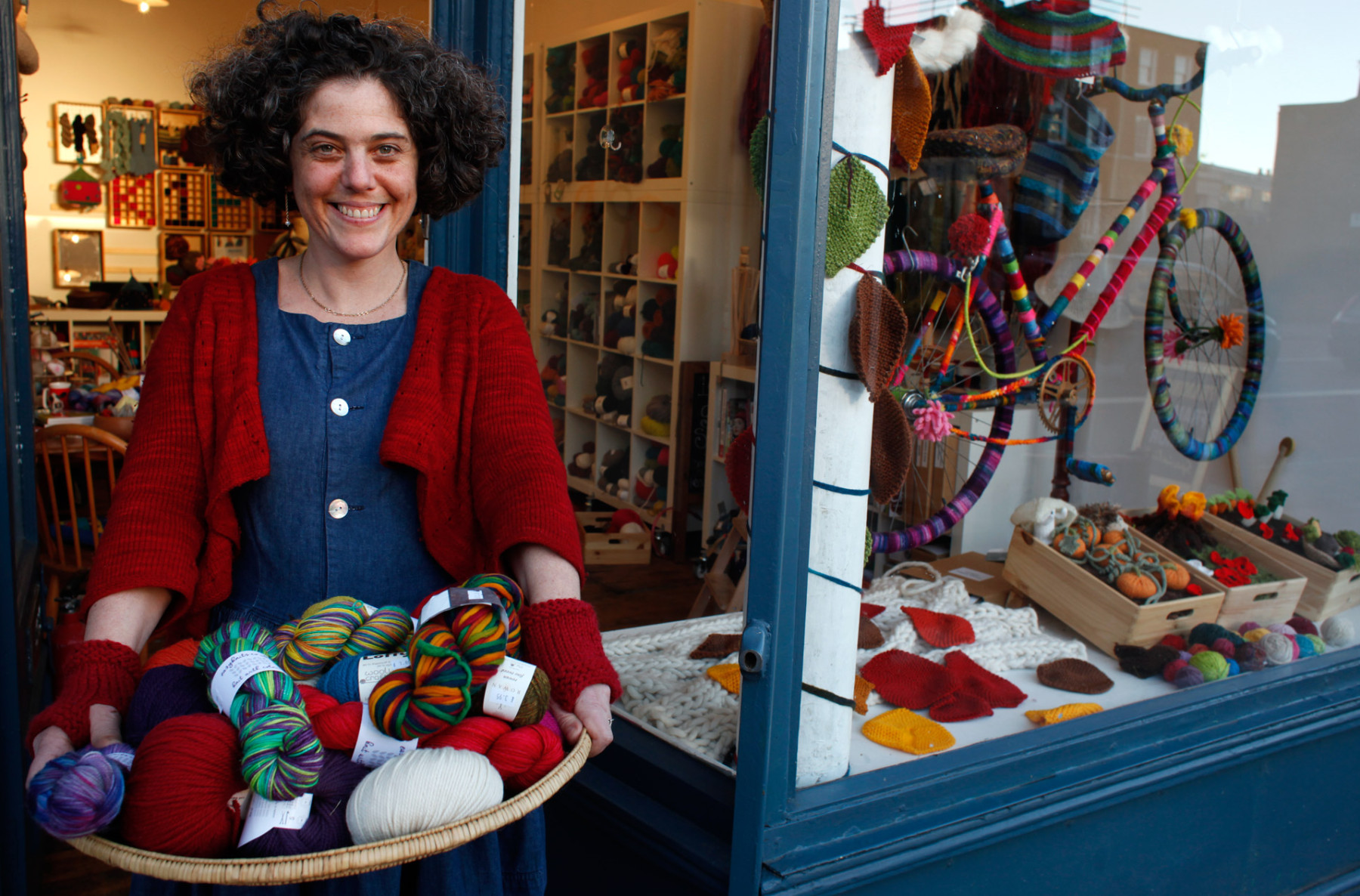“I’d see her through the window when I came home from school. She’d sit by the window where there was good light, with a big basket full of mending”
Judit Gummlich describes how it was when her beloved grandmother came to stay, to help with taking care of her and her siblings while her mother was working.
“She embroidered little flowers on the mended areas and I loved those little flowers. They made me feel extra special. They were were like a greeting from my grandma. And I loved her a lot.“
Judit is explaining the origins of her fascination with embroidery and her new book, Embroidery on Knits. As we talk, she’s adding petals to the stem of a plant on the back of a hand knitted mitten. Her work is deliberate and focused but it also has an un-hurried and fluent way about it. She knows exactly where she wants the needle to penetrate the fabric. Her hands continue to sew with this quiet confidence throughout our conversation.
I first learned about Judit’s plan to write a foundational reference book for embroidery on hand kniting, in early 2021 when she asked me to write the foreword for the book. We were in deep lock-down and Judit’s description of the book felt like a glimmer of sunshine amidst all the COVID19 gloom. Before the pandemic, I’d come to look forward to her 6 monthly visits to London from her home in Hamburg, not least so I could see what new stitchy flora and fauna was growing along her cardigan necklines and button bands. I understood her idea for the book as somehow bottling up the How-Tos of her extraordinary embroidery skills in an accessible way for knitters. This was more-than-welcome good news.
“I knitted as a chid and I really liked it. My mother had a lot of handicraft books including a collection of Brigitte magazines with fantastic knitting patterns.“
Her knitting progressed to making football scarves for friends, and even copying a stripey Paul Smith scarf, but it all became more serious with the arrival of her niece, Elise, for whom Judit assumed the role of most knitterly aunt.
“Then I became a passionate knitter!” she announces. This change in intensity was like a graduation to a new level. From discovering the spectacular colours of hand dyed yarns at Loop in London, to finding her knitting home and community at Mylys in Hamburg, to travels through Ravelry and amongst followers on Instagram, Judit’s knitting became as prolific, as her embroidery was abundant.

Judit explains how throughout this period, her long-standing interest in textile pattern mixes and structure developed into a love of haute couture. As she talks, I begin to see the two stitchy pathways of her textile journey: one a love of knitting and the other a passion for embellished textiles. The beautifully embroidered mitten in her hands was a perfect example of the way the two have settled in together like they were always supposed to be like that.
Of knitting now, Judit says, “Fairisle is still my favourite. At first it was intimidating. Then I mastered it and I fell in love with colourwork.”
“At the same time I love how embroidery dances on the surface.”

I look again at the little mitten with its rows of neatly knitted stitches. By contrast the embroidered stem and leaves curve and nod irregularly to each other through a little spray of yellow knotted blooms. Purists may struggle with this idea of altering hand knitted fabric with freely formed embroidered stitches. But the more I look, the more I see Judit’s transformation of the fixed grid of knitting with threads that take contrasting directions and textures, as a celebration of the fabric, rather than a disruption.

And the wonderful thing about the book is that she gives us the tools to do that too. Techniques, materials and ideas for designs illustrated with examples of dragonflies, birds, climbing flowers and fantastical trees.

“It’s about scale. Embroidered stitches need to hold on against the knitting. You don’t want your stitches to be so tiny that they disappear. People are afraid of big stitches. There are so many rules that knitters carry with them – like the wrong side should be as pretty as the right side, or big stitches mean you are lazy. We need to un-learn these rules and enjoy so we can feel ok with what we make”
And it’s clear that through this unlearning and dismantling of barriers, we will of course learn more. For those who want a hand to hold onto as they begin, the book includes actual sized templates to follow, but ultimately this is a book that will give you the confidence to embroider in your own voice with your own materials. It’s a new stitch language but in her careful, deliberate way, Judit makes this lexicon accessible for all of us.
As Judit says, “All you really need is an embroidery hoop and left-over yarn.” And as we all know, all knitters have leftovers..
Judit has her grandmother to thank for inspiring a life-long fascination with decorative stitches. Now with Judit’s book, it feels like she’s giving the rest of us a way to explore and enjoy our knitting on a joyously decorative new level.

Judit Gummlich’s Embroidery on Knits will be available from 29 September 2023. She will also be at Wild and Woolly for a talk + Q&A and book signing with her photographer collaborator, Simone Hawlisch at on 20 October 2023.

